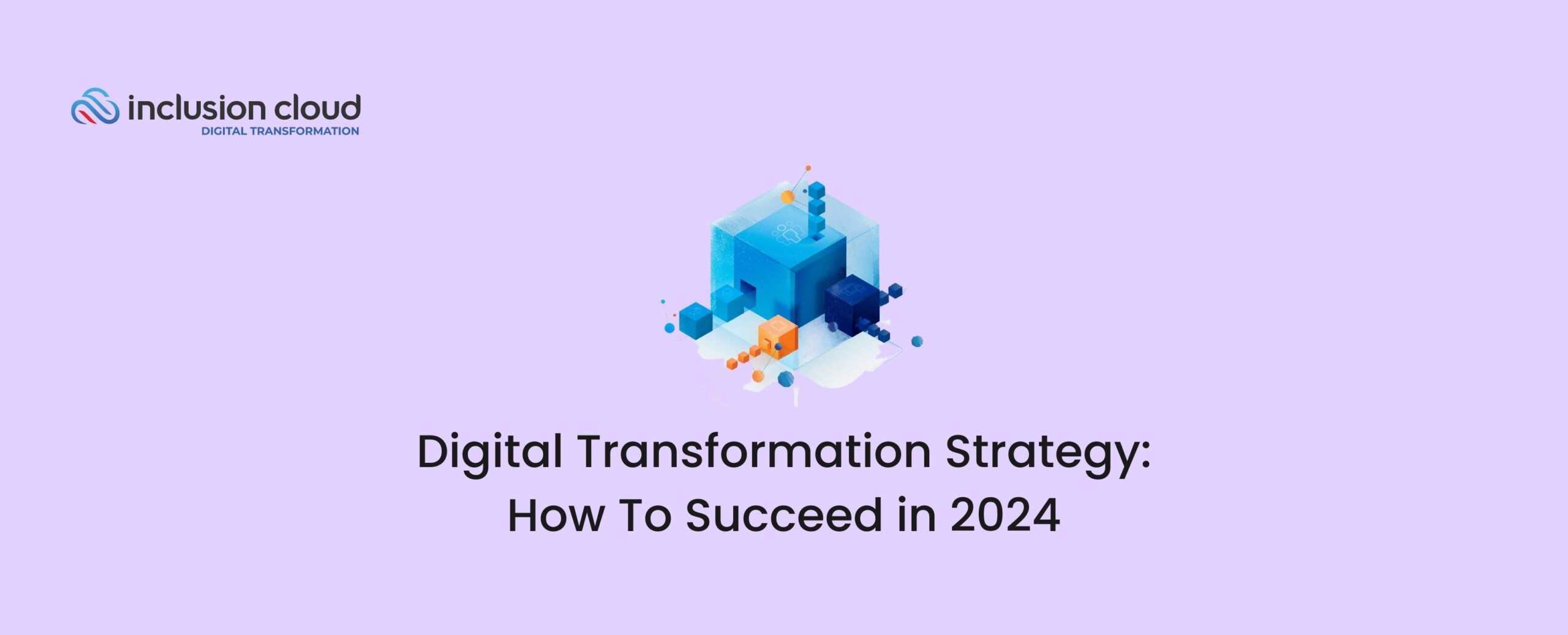Digital Transformation: Why Do You Need a Good Strategy?
Digital transformation has become a buzz phrase for organizations. But often, its meaning or the reasons for its need are unclear.
Let’s start by understanding what digital transformation is: The integration of digital technologies into different areas and processes of an organization. In addition, digital transformation is based on two pillars: a technological part and a cultural one.
Amid economic uncertainty, where a soft landing is anticipated yet concerns about inflation and recession loom, one thing is sure: companies are seeking ways to cut costs without compromising service or product quality. And the digitization of different processes allows organizations to:
- Improve their operations.
- Minimize costs.
- Increase communication levels between teams.
- Maximize efficiency and productivity.
But it’s not just about cost for organizations looking to digitally transform in 2024. The generative AI boom that started in 2023 demands substantial infrastructure for impactful outcomes. This includes computational resources, easily supplied by cloud services, allowing for flexibility and efficiency. Equally crucial is the seamless operation of data pipelines to ensure generative AI results are secure, reliable, and appropriately contextualized to the specific industry, services, and products offered, and each business’s unique requirements.
But digital transformation should not be a goal in itself. Rather, it is a process of technological and cultural changes in companies that allow them to achieve better results, more agile processes, and the satisfaction of the new consumption habits of clients (increasingly accustomed to digitalization).
For these changes to occur, it is an essential requirement to have a digital transformation strategy that helps companies achieve the desired objectives and adapt to the digital age. There are different plans to achieve the goals and it is important to consider your company’s characteristics and needs.
However, one of the most effective strategies trending in 2024 is opting for an outsourcing provider. This is one of the best options to speed up the transformation process since part of the responsibility is delegated to technology experts. In this way, companies can focus on improving their core business, instead of overspending internal resources to solve problems and challenges in which they aren’t experts.
In the following article, we will talk about the obstacles that organizations face on their way to digital transformation and the strategies to maximize results and minimize costs while processes are digitized.
What Are the Benefits of Digital Transformation for Companies?
As we said, digital transformation is a must for companies. It has been repeated that incorporating technology into as many areas as possible is essential for businesses to be prosperous. But why?
These are some of the benefits for companies to start the path of digital transformation:
1. Predicts consumption patterns:
In a digitalized (it must be said that the pandemic accelerated this process) and highly competitive world, customer consumption and habits are also digital. For this reason, customers expect on-demand services to be provided that meet their expectations. For this, there are great opportunities for companies in terms of data analysis that facilitates providing highly personalized services and knowing customer feedback.
2. Improve efficiency and productivity:
It is often difficult for employees to change practices that have been held for years. Whether it is about tasks, the use of software, or directly digitizing a task that was done manually. For this reason, if the correct balance between technology and practices is considered, productivity increases will be achieved through a healthy digital culture in workspaces.
- The use of collaborative digital tools can produce improvements in the coordination and communication of different areas or teams, in addition to allowing seamless work to obtain better results in less time.
- Other benefits in terms of efficiency and productivity are related to process automation, which not only avoids human error but also greatly reduces the time of each task. In this way, generative AI tools, like Chat GPT, also help teams free up tedious tasks to focus on others more related to the core of the business or spend more time on design and creativity.
- Another aspect that digitization facilitates is carrying out performance evaluations and real-time control of tasks that require follow-up.
- With the digitalization of most operations providing a vast amount of data, executives will gain valuable insights for decision-making, enhance predictability, and enable more accurate and customized training of AI models, among other benefits.
- Prevents burnout as it reduces the burden of tasks and the manual work of employees.
3. Reduce costs:
One of the objectives of the digital-driven model is the digital acceleration of the business process to reduce costs. With the incorporation of automation, AI, and data analysis, it is possible to optimize the supply chain of companies, as well as the necessary amount of labor for production.
- Document digitization and cloud services also allow the automation of administrative tasks that would otherwise take a long time and increase the chances of human error. Aside from task completion times being shortened, executives also have a much easier time making decisions thanks to the large amount of data made available by the digitization of business operations.
- The use of software for worker training or to automate the entire sales or marketing process is a very valuable element that will allow companies to cut the budget allocated to these areas considerably.
4. Increase revenues through innovation:
As mentioned above, the ability to streamline a company’s operations through automation or generative AI that reduces the time and work required to accomplish a task allows more time to be spent on planning but also innovation.
But how can revenue be increased from innovation? Let’s see:
- New technologies allow the creation of new products faster: For example, generative design exploits the power of AI to provide a range of solutions that meet a set of constraints. Unlike traditional design, where the process starts with the engineer’s insights, generative design requires only some input from the engineer (a series of instructions) and the AI creates the solution.
- Better marketing strategies: The reduction of costs in different areas due to digitization allows a larger budget to be allocated to brand development and marketing campaigns. Many data analysis tools are critical to understanding customer needs and launching highly personalized and effective campaigns.
- Facilitates new profitable business models: Digitization allows thinking of new strategies and business models to generate value where income was not traditionally achieved. There are numerous digital business models, including Free-Model (ad-supported), Freemium Model, On-Demand Model, eCommerce Model, and others.
What Are the Barriers that Hinder Digital Transformation?
Just to be clear, digital transformation is not a simple process. Modernizing the operations of a company is an arduous path that implies not only the incorporation of new technologies but also a whole change in the work culture. Next, we will give some examples, so that you can identify some of the obstacles that companies that are traveling this route face:
- Wrong strategy.
- Problems communicating.
- You don’t have the right experience.
- Work culture doesn’t fit.
- You have a low budget.
Below we will see some of the keys and strategies that will allow overcoming obstacles (internal and external) to advance with digitization and take your company to the next level.

Steps to Achieve a Successful Digital Transformation Strategy in 2024
With our expertise of +15 years in the market helping companies with technological solutions, we want to share a series of essential keys to achieving success on this journey:
Set your goals clearly:
For the construction of a safe and durable building, it is important to lay a solid foundation. In this sense, digital transformation does not begin with the application of technology but rather begins by planning a strategy related to the company’s long-term objectives. Once the steps to follow and the general goals and partial objectives are thought of, technology will be the lever that will allow them to be carried out.
Remember, you’re working with people:
It’s natural to face some resistance when starting a large-scale project. Preparing people for process changes is crucial: on one hand, providing tools and training is essential for adapting to new technologies. Take, for example, the AI adoption case: According to Salesforce, 70% of non-users would use generative AI more if they knew more about the technology. On the other, communication is key to helping teams understand the reasons for changes and their alignment with the company’s long-term goals.
Measure and adjust:
Carefully choosing the KPIs that you want to measure will allow each step that is taken to be in the direction of the organization’s goals. It is also important to have the appropriate tools for the measurement and analysis of the data obtained to confirm whether the initial plan is adequate, or if, on the contrary, some strategic adjustments must be made.
Build the right team (considering the expertise):
A balanced team, from managers to entry-level employees, is essential for success. Having onboard professionals with experience in applying and developing technology is highly beneficial. Moreover, in the age of generative AI, the demand for hyperspecialization—deep, specific knowledge in emerging technologies—is critical. Multidisciplinary teams that combine various strengths, a shared vision, and soft skills such as communication and management are crucial. To bridge the talent gap, especially in highly specialized areas, partnering with an outsourcing vendor can provide access to the necessary expertise to advance into the digital era.
Don’t be afraid to seek help:
At this point, you will understand that digital transformation is a complex process with many angles. Therefore, a highly advisable alternative is to hire a provider to help you implement the transformation in a reliable, efficient manner and even minimize costs. Below we will see why outsourcing is a great option to consider.
Is Outsourcing the Answer?
Companies, regardless of which industry they belong to, are migrating toward digitization. In highly competitive markets, this is one of the answers that will allow them to continue being sustainable companies with high degrees of predictability. For this reason, we believe that you should consider outsourcing as a great alternative to start the path of transformation with safe steps. And not only this but also optimizing process times, since there are providers with vast experience helping companies with digitization.

Here are some of the reasons why outsourcing is the right answer:
- Optimize your budget: Software development is crucial for digitization as it provides many growth opportunities for businesses through automation, AI, machine learning, and big data. Software development is much less expensive through outsourcing. And, in addition, different outsourcing models can be adjusted to each need of your company, allowing you to reduce costs in the technology budget with confidence.
- Specialization: Technology development necessitates highly specialized professionals who can provide solutions. Furthermore, large-scale implementations require a lot of resources, and in-house software development is an expensive service. By outsourcing your project, you can reduce the budget on your tech staff and gain access to a large pool of talented specialists who possess specific skills.
- Expertise matters: Having an outsourcing provider that has expertise collaborating in the transformation of companies from different industries will be a great advantage for your company. In this way, you will not only be able to reduce costs but also carry out the changes with confidence, and you will be able to obtain the best quality in the products and services that the company offers.
- Drives innovation: By delegating part or all of the technology development process, companies will be able to focus on other activities linked to the core of the business. And in this way, more resources can be allocated to innovation to improve services or products (what really matters is keeping customers happy).
- Flexibility: This service model offers a lot of flexibility to companies. On the one hand, it is possible to empower an in-house team with some talent specialized in a particular technology (Staff Augmentation model). On the other hand, you can also hire an entire team for a specific project (Project Outsourcing model), according to the needs of each company.
Besides, developers who work for vendors are often used to changing work dynamics, so they have a great capacity for adaptability.
Conclusion
We are at a crucial moment, where companies must modernize and adapt to the digital age so as not to be relegated to highly competitive markets. And the digital transformation process can be very expensive if it is not carried out by specialists. The top priority for executives in 2024 is balancing IT budgets with innovation. As 75% of CEOs recognize, mastery of generative AI is key to competitiveness, requiring extensive infrastructure, not just in technology but also in bridging talent gaps, training employees, and fostering the right mindset for the digital age.
For this reason, we seek to help companies transform in a reliable and efficient way without compromising their budget. If you are interested in finding the best professionals in technology or consulting, contact us!





